Autumn 2023 (September, October, November)
Warm and wet overall. Heatwaves in September, flooding in October, four named storms
Autumn 2023 was the tenth consecutive season with above average temperatures at most stations. September was warm, sunny and wet. The first third of the month saw a tropical continental air mass over the country leading to heatwaves and the majority of stations reporting their highest temperatures of the year. Atlantic low pressure systems gradually became more dominant as the month progressed bringing spells of heavy rain and strong winds. The first named storm of the 2023/24 season, named storm Agnes by the Met Office (UK), brought widespread heavy rain and strong winds on the 27th. October was another mild month, especially during the first third of the month, with record October maximum temperatures in places. It was also very wet in the Midlands, South and East, especially during the second half of the month. Storm Babet, named by the Met Office (UK), brought several days of intense rainfall, which led to flooding in places. The South of the country saw record high October rainfall. November was mild overall but finished cold. It was wet in the Northwest and dry in the Southeast. Atlantic low pressure was dominant for the first two thirds of the month. The direct impacts from Storm Ciarán, named by the Met Office (UK), mostly missed Ireland to the south at the beginning of the month. Storm Debi, named by Met Éireann, brought heavy rain and strong winds as it crossed Ireland from southwest to northeast on the 13th. The final third of the month saw it turn progressively colder and drier with high pressure more dominant. The season finished cold with an arctic air mass bringing widespread frost.
Rainfall: Above average in most places, wettest in the South
Nearly all rainfall totals were above their Long-Term Average 1981-2010 (LTA) for the season. Percentage of seasonal rainfall values ranged from 83% (seasonal rainfall total of 316.9 mm) at Belmullet, Co Mayo to 166% at both Cork Airport, Co Cork and Johnstown Castle, Co Wexford (its wettest autumn on record, length 82 years) (seasonal rainfall total of 586.8 mm and 540.1 mm respectively). Seasonal rainfall totals ranged from 269.7 mm (125% of its LTA) at Casement Aerodrome, Co Dublin to 607.4 mm (128% of its LTA) at Valentia Observatory, Co Kerry. The highest daily rainfall total was 57.9 mm at Mace Head, Co Galway on Sunday 24th September. The number of rain days ranged from 55 days at Phoenix Park, Co Dublin to 76 days at Sherkin Island, Co Cork. The number of wet days* ranged from 41 days at Phoenix Park, Co Dublin to 59 days at Valentia Observatory, Co Kerry. The number of very wet days* ranged from 7 days at Malin Head, Co Donegal to 23 days at Valentia Observatory, Co Kerry. Along with Johnstown Castle, Roches Point, Co Cork also had its wettest autumn on record with 474.6 mm (164% of its LTA). Cork Airport, Co Cork had its highest daily fall for autumn since 1995 with 55.6 mm on Wednesday 18th October during storm Babet.
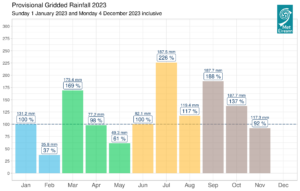
Provisional monthly gridded 2023 rainfall (%) for Ireland on a monthly basis.
Temperature: Above average everywhere
All mean air temperatures across the country were above their LTA for the season. Deviations from mean air temperature ranged from 0.6 °C (10.6 °C mean temperature) at Markree, Co Sligo to 1.5 °C (11.6 °C mean temperature) at Phoenix Park, Co Dublin. Mean temperatures for the season ranged from 10.2 °C (1.2 °C above its LTA) at Knock Airport, Co Mayo to 12.8 °C (0.8 °C above its LTA) at Sherkin Island, Co Cork. The season’s highest temperature was reported at Oak Park, Co Carlow on Friday 8th September with a temperature of 28.5 °C (its highest autumn temperature on record (record length 18 years)). Both the season’s lowest air and grass minimum temperatures were recorded on Thursday 30th November at Mount Dillon, Co Roscommon. The lowest air minimum was -5.1 °C while the lowest grass minimum was -9.0 °C. More than half of stations reported ground frost. The number of days with ground frost ranged from zero days at Malin Head, Co Donegal to 30 days at Mount Dillon, Co Roscommon. More than half of stations reported air frost. The number of days with air frost ranged from zero days at a few stations to 15 days at Mount Dillon, Co Roscommon. Along with Oak Park, thirteen other stations broke their autumn maximum temperature record with record lengths between 12 and 81 years.
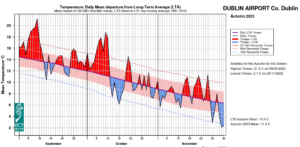
Dublin Airport, Co Dublin Temperature: Daily mean departure from LTA for Autumn 2023 based on 09-09hr Max/Min values.
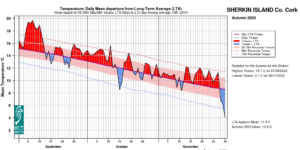
Sherkin Island, Co Cork Temperature: Daily mean departure from LTA for Autumn 2023 based on 09-09hr Max/Min values.
Sunshine: Above average, sunniest in the Southeast
All available sunshine totals were above their LTA for the season. Percentage of seasonal sunshine values ranged from 106% (seasonal sunshine total of 310.4 hours) at Casement Aerodrome, Co Dublin to 112% (seasonal sunshine total of 300.7 hours) at Shannon Airport, Co Clare. Seasonal sunshine totals ranged from 255.9 hours (No LTA comparison*) at Valentia Observatory, Co Kerry to 345.0 hours at Johnstown Castle, Co Wexford (No LTA comparison*). The highest number of daily sunshine hours recorded this season was 12.6 hours at Malin Head, Co Donegal on Monday 4th September. The number of dull days* ranged from 21 days at Casement Aerodrome, Co Dublin to 29 days at Malin Head, Co Donegal.
Wind: Storm force winds reported. Strong gales reported in September during storm Agnes and in November during storm Debi
Seasonal mean wind speeds ranged from 5.4 knots (10.0 km/h) at Moore Park, Co Cork and Ballyhaise, Co Cavan to 15.5 knots (28.7 km/h) at Malin Head, Co Donegal. Gales were reported on numerous days with up to strong gales reported on Wednesday 27th September during storm Agnes, Friday 20th October and Monday 13th November during storm Debi. Storm force winds were reported on Wednesday 1st November (associated with a secondary low to storm Ciarán). The number of days with gales ranged from zero days at a few stations to 12 days at Malin Head, Co Donegal. The number of days with up to strong gales ranged from zero days at most stations to 2 days at a few stations. The season’s highest gust was reported at Sherkin Island, Co Cork on Wednesday 27th September during storm Agnes with 63 knots (117 km/h). The season’s highest 10-minute mean wind speed was 48 knots (88 km/h) at Mace Head, Co Galway on Wednesday 1st November.
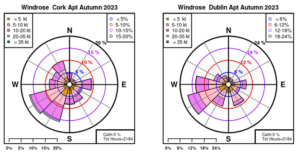
Cork Airport, Co Cork and Dublin Airport, Co Dublin: Wind Roses for Autumn 2023
The full report is available here (choose Autumn on drop down menu for month) or the PDF is available here

Autumn 2023 extreme values at synoptic stations
November
Mild overall, cold finish. Wet in the Northwest, dry in the Southeast
The first two thirds of November 2023 saw Atlantic low pressure systems dominate. This brought above average temperatures with rain or showers on most days, especially in the West and Northwest. The final third of the month saw high pressure having more of an influence with drier and progressively cooler conditions. The month began with a broad trough of low pressure positioned over Ireland and the UK, which had several individual low centres associated with it. One low centre to the northwest of Ireland, brought bands of rain or showers and strong winds, especially to the Northwest. At the same time another low centre, named storm Ciarán by the Met Office (UK), developed into a vigorous depression and moved from west to east, to the south of Ireland. Further Atlantic low pressure systems brought frontal rain across the country from the southwest on the 4th and 8th, interspersed with sunshine and showers. A rapidly developing low pressure, named storm Debi by Met Éireann, moved across the country from southwest to northeast on the 13th. This brought a swath of very strong and damaging winds, along with widespread heavy rain. Low pressure stayed in control up to the 20th. The final third of the month was relatively dry with high pressure in charge. It became progressively colder towards the end of the month with frost and fog in places as an arctic air mass moved in over the country from the north and northeast.
Rainfall: Above average in the Northwest and North, below average in the Midlands, South and East
Most of the monthly rainfall totals across the country were below their 1981-2010 Long-Term Average (LTA). Percentage of monthly rainfall values ranged from 53% (monthly rainfall total of 79.2 mm) at Mace Head, Co Galway to 129% (monthly rainfall total of 172.8 mm) at Knock Airport, Co Mayo. Monthly rainfall totals ranged from 41.2 mm (56% of its LTA) at Casement Aerodrome, Co Dublin to 209.6 mm (123% of its LTA) at Newport, Co Mayo. The month’s wettest day was also recorded at Newport, Co Mayo with 45.9 mm on Monday 13th. The number of rain days ranged from 18 days at Roche’s Point, Co Cork to 28 days at Valentia Observatory, Co Kerry. The number of wet days* ranged from 12 days at a few stations to 23 days at Valentia Observatory, Co Kerry. The number of very wet days* ranged from zero days at both Oak Park, Co Carlow and Casement Aerodrome, Co Dublin to 6 days at Knock Airport, Co Mayo.
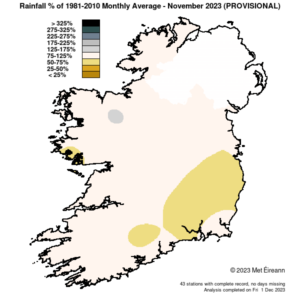
Rainfall % of 1981 – 2010 Monthly Average for November 2023 (Provisional)
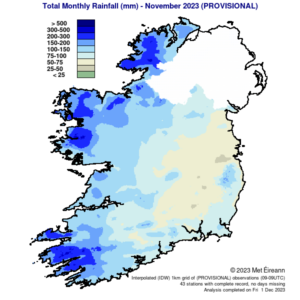
Total Monthly Rainfall (mm) for November 2023 (Provisional)
Temperature: Above average in most places
Nearly all mean air temperatures were above their LTA for the month. Deviations from mean air temperature ranged from -0.4 °C at Ballyhaise, Co Cavan and Markree, Co Sligo (6.8 °C and 7.0 °C mean temperatures respectively) to 0.7 °C at Phoenix Park, Co Dublin, Oak Park, Co Carlow, Belmullet, Co Mayo and Sherkin Island, Co Cork (7.8 °C, 7.9 °C, 9.1 °C and 10.2 °C mean temperatures respectively). Mean temperatures for the month ranged from 6.6 °C (0.4 above its LTA) at Knock Airport, Co Mayo to 10.2 °C (0.7 °C above its LTA) at Sherkin Island, Co Cork. The month’s highest temperature was reported at Phoenix Park, Co Dublin on Saturday 18th with a temperature of 14.6 °C. Both the month’s lowest air and grass minimum temperature were recorded on Thursday 30th at Mount Dillon, Co Roscommon. The lowest air minimum was -5.1 °C while the lowest grass minimum was -9.0 °C. More than half of stations reported ground frost. The number of days with ground frost ranged from zero days at Malin Head, Co Donegal to 19 days at Mount Dillon, Co Roscommon. More than half of stations reported air frost. The number of days with air frost ranged from zero days at a few stations to 9 days at Mount Dillon, Co Roscommon.
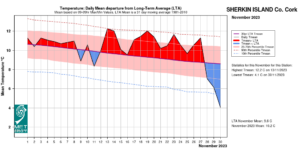
Sherkin Island, Co Cork temperature: Daily mean departure from LTA for November 2023
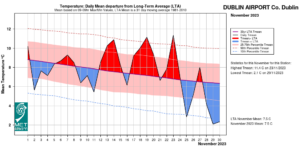
Dublin Airport, Co Dublin temperature: Daily mean departure from LTA for November 2023
Sunshine: Above average, highest in the South
All available sunshine totals were above their LTA. Percentage of monthly sunshine values ranged from 105% (monthly sunshine total of 68.9 hours) at Casement Aerodrome, Co Dublin to 131% (monthly sunshine total of 77.8 hours) at Shannon Airport, Co Clare. Monthly sunshine totals ranged from 51.9 hours (no LTA comparison*) at Malin Head, Co Donegal to 101.2 hours (no LTA comparison*) at Cork Airport, Co Cork. The highest number of daily sunshine hours recorded this month was 8.1 hours at Johnstown Castle, Co Wexford on Friday 3rd. The number of dull days* ranged from 5 days at both Johnstown Castle, Co Wexford and Cork Airport to 10 days at Malin Head, Co Donegal.
Wind: Storm force winds reported and strong gales reported during storm Debi
Monthly mean wind speeds ranged from 5.3 knots (9.8 km/h) at Ballyhaise, Co Cavan to 17.2 knots (31.9 km/h) at Mace Head, Co Galway. Gales were reported on the 1st, 7th, 8th, 9th, 10th, 13th and 19th. Strong gales reported on Wednesday 1st at Mace Head and Malin Head, Co Donegal (associated with a secondary low to storm Ciarán) and Monday 13th at Mace Head, Finner, Co Donegal and Roches Point, Co Cork during storm Debi. Mean wind speeds reached storm force on Wednesday 1st at Mace Head, Co Galway (associated with a secondary low to storm Ciarán). The number of days with gales ranged from zero days at a few stations to 7 days at Sherkin Island, Co Cork. The number of days with up to strong gales ranged from zero days at most stations to 2 days at Mace Head, Co Galway. The number of days with storm force winds was 1 day at Mace Head, Co Galway. The month’s highest gust was reported at Athenry, Co Galway on Monday 13th with 62 knots (114 km/h) during storm Debi (its highest gust for November on record (record length 13 years)). The month’s highest 10-minute mean wind speed was 48 knots (89 km/h) at Mace Head, Co Galway on Wednesday 1st. Along with Athenry, two other stations had their highest gust for November on record during storm Debi. These were Dunsany, Co Meath with 53 knots (98 km/h) (length 17 years) and Mount Dillon, Co Roscommon with 57 knots (106 km/h) (length 19 years). Mullingar, Co Westmeath had its highest gust for November since 1996 with 53 knots (98 km/h), also during storm Debi.
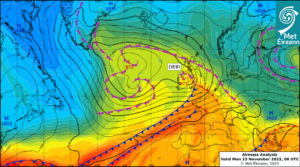
Airmass Analysis chart 06 UTC 13 November 2023 with storm Debi
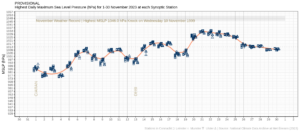
Highest daily mean sea level pressure (MSLP) observed at all available stations for November 2023
The full report is available at https://www.met.ie/climate/past-weather-statements
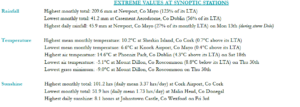
November 2023 extreme values at synoptic stations
Recent Novembers in Ireland:
- 2016: Nearly all stations reported below Long-Term Average (LTA) rainfall values. All stations reported mean air temperatures below their LTA. Sunshine values were above average while gales and thunderstorm activity were reported.
- 2017: Rainfall totals were below their LTA at most stations. All mean temperatures were below. Sunshine totals were above average while gales and strong gales were reported at some stations.
- 2018: The majority of monthly rainfall totals were above their LTA. Nearly all mean temperatures were above their LTA for the month. Sunshine totals variable and Storm Diana brought strong gale force winds.
- 2019: The majority of monthly rainfall totals were above their LTA. All mean air temperatures were below. Sunshine totals were variable and strong gales were reported.
- 2020: The majority of monthly rainfall totals were above their LTA. All mean air temperatures were above their LTA. Nearly all sunshine totals were above average and strong gales were reported.
- 2021: Nearly all rainfall totals were below their LTA. All mean air temperatures were above their LTA while nearly all sunshine totals were above average. Strong gales were reported, and Storm-force winds were recorded during storm Arwen.
- 2022: The majority of monthly rainfall totals were above their LTA. All mean air temperatures and sunshine totals were above their LTA. Strong gales and storm-force winds were reported.
*Issued by Met Éireann on Monday 4th December 2023. This report is based on available preliminary data from 25 principal weather stations operated by Met Éireann. Synoptic station data is daily, which is midnight to midnight UTC. Long-Term Averages (LTAs) and “average” refer to the period 1981-2010. A wet day is a day with 1.0 mm or more of rainfall. A dull day is a day with less than 0.5 hours of sunshine. A very wet day is a day with 10.0 mm or more of rainfall. Climatological dry periods – An absolute drought is a period of 15 or more consecutive days to none of which is credited 0.2 mm or more of precipitation. A partial drought is a period of at least 29 consecutive days, the mean daily rainfall of which does not exceed 0.2 mm. A dry spell is a period of 15 or more consecutive days to none of which is credited 1.0 mm or more of precipitation (i.e. daily tot < 1.0 mm). A heatwave occurs at a Met Éireann station when the daily maximum shaded air temperature is greater than twenty-five degrees Celsius (> 25.0°C) for five or more consecutive days. *Sunshine data is from the Autosol Network. LTAs for these sites are currently not used for comparison purposes. For more information, contact Met Éireann at 01-8064200 or e-mail: enq@met.ie